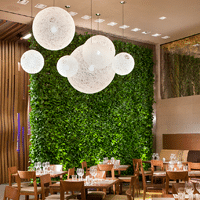Just outside Chicago is the suburb of Des Plaines, home to 60,000 residents and the world’s first McDonald’s. It’s a quiet, residential town and now the home of a 147,000-square-foot casino.
But this isn’t your average casino. In 2007, Midwest Gaming announced plans for Rivers Casino, a LEED Gold facility to be erected on a 20-acre lot near the busy intersection of Des Plaines River Road and Devon Avenue. The city of Des Plaines took the news the standard way: with a mixture of curiosity and ambivalence.
Jason Westrope, a LEED AP and development manager at the Chicago-based Development Management Associates (DMA), explains that, due to the history of casinos, people often scrutinize new casino construction. “But a casino is a big building, like an office or hospital, and part of the skepticism derives from how this new structure reflects the community it is in,” he says. “That’s why it was important for us to set a high design standard for Rivers Casino and make it something special.”
Completed in 2011, Rivers Casino is the first casino in the world to receive LEED Gold certification, awarded in part for its widespread implementation of LED lighting, low-flow plumbing fixtures, lighting occupancy sensors, and diverting 90 percent (35,330 tons, or about the weight of an aircraft carrier) of its construction waste from the landfill.
“Rivers Casino took an underutilized site of prime, riverside property and has really set an example for future sustainable building design in the community.”
Jason Westrope, LEED AP
Although this was DMA’s fourth casino with Midwest Gaming, it was the first for which it was brought on to do LEED consulting. Westrope says, “Though we’ve managed the development of other casinos, the location of Rivers and its proximity to Chicago really caused us to pay attention to the design quality while adhering to a firm budget and meeting all of our sustainability goals.”
Incorporating LEED elements into the design was not an initial aspect of the plan; although with the approval of Midwest Gaming, DMA was able to run a quick analysis on the project to assess the feasibility of LEED scores. “We estimated we would be able to attain LEED Silver,” Westrope says, “though around this same time, the City of Des Plaines was asking us to help deliver a LEED building in their district.”
The decision to shoot for the LEED label was obvious, but because the design phase was taking place at the height of the economic downturn, making the investment to achieve LEED while staying on budget was an obstacle. “Our only request, when working with the City of Des Plaines, was that they give us freedom to achieve the highest level of LEED certification possible without new mandates or expectations,” Westrope says. City leaders granted this opportunity, and this freedom to explore the most suitable green improvements allowed Rivers Casino to present the city with a LEED Gold casino—and bragging rights to the first casino of its kind—as well as to reinforce reciprocal trust between the casino and the city.
“Above all else, innovative, more environmentally connected design was an integral part of Rivers Casino’s efforts to set a new standard for regional casino projects,” Westrope says. In a revolutionary move, DMA, working with Las Vegas-based Klai Juba Architects, incorporated skylights into the 43,000-square-foot gaming space. Although many casinos seek to obscure the passage of time by reducing the amount of daylight visible from the casino floor, Rivers Casino welcomes it and allows for a more naturally inspired and friendly gaming experience. The casino also includes two internal and several exterior living walls, which are planted with live flora to expand the innovations blending the interior and exterior spaces.
Based on these design innovations and a highly efficient physical footprint, Rivers Casino generates just as much revenue at half the square footage of its local casino competitors. “By designing an efficient space, Klai Juba was able to heavily impact our sustainable goals by being both cost-effective and environmentally efficient in the most fundamental way,” Westrope says.
“Rivers Casino took an underutilized site of prime, riverside property and has really set an example for future sustainable building design in the community,” Westrope adds. “It has created thousands of jobs, boosted the local economy, and been an important first for the city of Des Plaines.”
Now, in addition to being the home of the world’s largest fast-food chain, Des Plaines can brag about its green casino.

